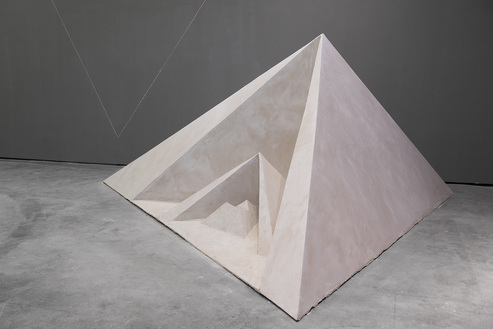-
From Current Issue
-
- Editor’s Letter Fire in the Heart
- Reviews I Gusti Ayu Kadek Murniasih
- Reviews 11th Seoul Mediacity Biennale: “One Escape at a Time”
- Dispatch Networked China
- One on One Monira Al Qadiri on Yukio Mishima
- Essays The rise of independent art spaces in pandemic-era Shanghai
- Features Tuan Andrew Nguyen
- Table of Contents
- Web Exclusives
- Archive
- Subscribe

R
E
V N
E
X
T
Installation view of LIU YUE’s “Volume,” at ShanghArt M50, Shanghai, 2019. All photos by Alessandro Wang; courtesy the artist and ShanghArt Gallery, Shanghai / Beijing / Singapore.
To enter Liu Yue’s latest solo exhibition at ShanghArt M50, the visitor had to climb a staircase to an elevated plateau. The surrounding walls, matching the concrete floor, were painted a serious gray. Against this tone was a succession of sculptural geometric forms, dramatic chevrons of plaster in the palest neutral tints. One towered up to the roof, others crouched immovable on the floor or clung tightly to the walls. The works often suggest magnificent pyramids seen from afar, yet the way in which recurring forms are carefully nestled within one another, like mathematical instruments fitted neatly into a box, simultaneously reveals microscopic detail. Only blemishes on the troweled surfaces rent during fabrication offset this apparent precision. Chalky deposits—the scourge of working with plaster—marred the floor of the display, attesting to recent activity.
“Volume” was the first exhibition in ShanghArt’s newly renovated M50 gallery. The refurbishment of the lofty post-industrial site proved an act of subtraction, removing partitions and opening a vertiginous atrium, now traversed with exposed steel walkways. Liu worked on-site for a month and a half, creating seven interconnected sculptures. These also appeared to be the outcomes of removal, as if his work was to erode, to take away solid matter, leaving just a resonance of the space. Rising from wide bases, the sloping sides of the objects defined a meandering angular route across the room, where negative space was palpable.
Installation view of LIU YUE’s Volume – ShanghART M50 01, 2019, plaster and other synthetic materials or stainless steel, varnish, 16 × 16 × 16 cm, at “Volume,” ShanghArt M50, Shanghai, 2019.
The process that generated the objects was made explicit in a smaller inner room. Here, lodged at the point where a corner met the floor, was a little plaster cube. It formed a center from which a series of inscribed triangles radiated across the floor and up the walls, their apexes rising above the cube. These lines configured the other six forms. The simplest, for example, a tetrahedron attached to the wall, appeared to be a cast of the corner setup, with the cube having left a sharp hollow at the summit of three slopes.
Installation view of LIU YUE’s Volume – ShanghART M50 05, 2019, plaster and other synthetic materials or stainless steel, varnish, 256 × 189.5 × 211 cm, at “Volume,” ShanghArt M50, Shanghai, 2019.
Across the room from the cube sat a low pyramid. The perimeter of its base could be mapped to one of the drawn outlines. This sculpture was the fifth in a sequence of forms that grew incrementally in size and complexity, resulting in dizzying patterns, as the system for deriving these structures became increasingly elaborate. Like all of the works, the smoothed surfaces of 05 showed evidence of astringent energy applied at the moment when soft plaster solidifies. One face had a part cut away, revealing, embedded, an inverted structure of triangles. At the center of these was a miniaturized iteration of the cube and its situation. Inside the form were receding repetitions of its outer proportions, producing an effect reminiscent of Matryoshka dolls.
Following this arcane pattern, all sculptural ratios were in intimate harmony with the room. The essence of the sculptures, with their repeating inner details, was, in fact, not a function of the objects themselves but of the location, wrought from the dimensions of the space. This site has long been an annex to ShanghArt’s former, larger M50 venue—now relocated to the West Bund—and is the platform where artists and curators have been provided opportunities to explore their more radical and experimental ideas. With “Volume,” Liu has christened the renewed architecture with a memorial of sorts to past artistic metamorphoses, from idea to tangible work, within this building.
In 1981, American minimalist sculptor Richard Serra installed a monumental, unfinished steel plate, Tilted Arc (1981), at Foley Federal Plaza in Manhattan. When the work was removed in 1989, Serra famously argued in a public hearing that because Tilted Arc was site-specific, to remove it was to destroy it. In “Volume,” Liu adopted a pragmatic strategy in harmony with Serra’s argument. When the works are dismantled and removed, losing their bond with the space’s architecture, the principle of their proportions becomes obscure, the acts that created them unfathomable. On-site, they functioned as a sculptural guarantee: this space was not merely one in which art was displayed, but an active place from which art was engendered.
Liu Yue’s “Volume” is on view at ShanghArt M50 until October 20, 2019.
To read more of ArtAsiaPacific’s articles, visit our Digital Library.











